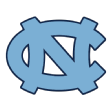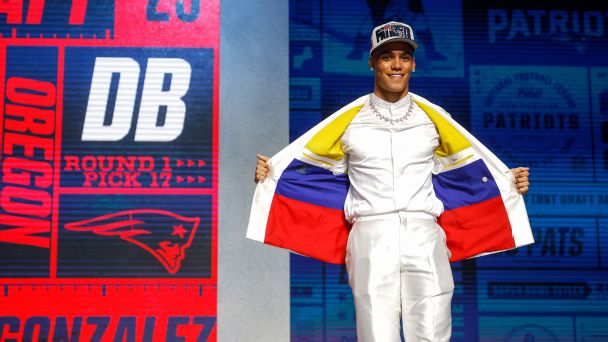

It used to be rare for a rookie wide receiver to make a big impact, but that paradigm is changing. A rookie wide receiver with 1,000 receiving yards may now be a perennial occurrence. Every NFL draft since 2019 has had a rookie receiver hit the 1,000-yard mark, and the 2022 draft had two (although that may partially be a function of the league moving to a 17-game season).
Wide receivers are no longer just a long-term investment -- they can make an immediate impact on a team's passing game.
Playmaker Score, Football Outsiders' metric for projecting top wide receiver prospects, shows that immediate impact can be expected from a couple of this year's top prospects, but another top-25 prospect comes in lower than expected.
Playmaker Score analyzes the player's peak college season along with other variables to project a player's receiving yards per season in his first five seasons.
Below, we take a look at some of Playmaker's top prospects in the 2023 NFL draft, along with some similar prospects from previous drafts. Our similar historical prospects are based on former players who were similar in their Playmaker statistics, so you might see us compare two physically dissimilar players because they were similar statistically.


Scouts Inc.: No. 14 overall
Similar historical prospects: Dez Bryant, Mike Evans
It might seem odd to say that a prospect who missed almost all of last season is the "safest" wide receiver in this draft, but that might be the case for Smith-Njigba. He had only one standout season at Ohio State, but it was really good -- 95 receptions, 1,606 yards and 9 touchdowns. Unfortunately, Smith-Njigba missed most of his follow-up season with a hamstring injury.
There is plenty of precedent, however, for receivers succeeding under similar circumstances. Dez Bryant, for example, was stellar as a sophomore but missed most of his junior season because of NCAA rule violations. Stefon Diggs is perhaps a more extreme example, as he was great as a freshman but struggled with injuries his next two years at Maryland. And, of course, there are many receivers who simply elected to enter the draft after a great sophomore season, including Larry Fitzgerald and Ja'Marr Chase.
Also, Playmaker likely underrates Smith-Njigba because he does not get an adjustment for playing with talented teammates. Smith-Njigba's only full season of production came in 2021, where he competed for receptions with future first-round wideouts Garrett Wilson and Chris Olave. However, since Wilson and Olave entered the draft in 2022, Playmaker does not give Smith-Njigba a bump. NFL decision-makers might note that Wilson and Olave had excellent rookie seasons, and Smith-Njigba was arguably the stronger player at Ohio State. (Njigba-Smith recorded more yards than Wilson and Olave, but he did not score as many touchdowns.) It would be surprising if Smith-Njigba is a total bust after recording what was, at worst, a comparable performance to Wilson and Olave at Ohio State.

Scouts Inc.: No. 29 overall
Similar historical prospects: Roy Williams, Andre Johnson
Addison falls just a few yards short of Smith-Njigba, for all intents and purposes tying him for this year's top projection. Addison's best season was 2021 at Pittsburgh, where he recorded 100 catches for 1,593 yards and 17 touchdowns and won the Fred Biletnikoff Award as the nation's best receiver. The Panthers were a fairly pass-happy team, attempting 543 passes, and thus Addison's rate stats were not as impressive as his raw numbers might suggest. Still, Addison's production was very good, especially his touchdowns.
Addison also receives a bump for being relatively heavily used in the running game. During his best season, he ran the ball seven times for 56 yards and a touchdown. It is somewhat unusual for a receiver to get such extensive use in both the passing and running games, which is a good sign for Addison.
Not as good is his 2022 drop-off in production. Addison was injured for three games and still led USC in receiving. However, he averaged only around 80 yards per game, low for an expected first-rounder. Overall, Addison is a good but not great prospect.

Scouts Inc.: No. 56 overall
Similar historical prospects: Allen Robinson II, Eric Moulds
Downs trails Smith-Njigba and Addison, but that is largely a function of Downs' slightly lower projected draft position. Downs' relatively high projection is due primarily to one factor: his yards per team attempt. In 2021, Downs caught 101 passes for 1,335 yards even though the Tar Heels passed only 380 times. His 3.51 yards per team attempt is the second-best of all wide receivers invited to the combine this year, behind only Arizona's Jacob Cowing.
Downs also gets a small boost from sharing a draft class with teammate Antoine Green, whom Scouts Inc. essentially projects as an undrafted free agent.

Scouts Inc.: No. 42 overall
Similar historical prospects: Tyler Boyd, Torrey Smith
Hyatt is Playmaker's favorite prospect in this year's draft if you ignore draft position. Although he falls short of some of the all-time great projections, Hyatt has a lot that Playmaker likes.
For one, Hyatt leads the class in receiving touchdowns per team attempt, recording a TD on 3.55% of Tennessee's pass attempts last year. This number will not break any records -- for example, during his best year, Randy Moss recorded a touchdown on nearly 7.5% of his team's pass attempts. However, it is still better than any of the combine invites in 2022 and nearly identical to Ja'Marr Chase's peak touchdowns per team attempt.
Hyatt also gets a substantial boost because he enters the draft with teammate Cedric Tillman, whom Scouts Inc. similarly rates as a second-round pick. Tillman missed roughly half of the 2022 season, but Hyatt still deserves credit for having to compete for catches with another highly touted prospect for a significant portion of the year.
For those curious, Tillman is not as impressive as Hyatt from Playmaker's perspective. Tillman's peak season was not as good as Hyatt's and Tillman enters the draft as a senior and receives a significant penalty from Playmaker as a result.

Scouts Inc.: No. 24 overall
Similar historical prospects: Reggie Williams, Laquon Treadwell
Johnston falls behind Downs and Hyatt in Playmaker by the smallest of margins. However, it is somewhat amazing that Playmaker thinks that Johnston, the consensus No. 1 wide receiver in this year's draft, is just as likely to succeed as two second-round picks even after factoring in draft position.
Johnston is a good prospect, but Playmaker thinks he is not quite as good as his pre-draft projection would suggest. In 2022, Johnston had 60 receptions for 1,069 yards and 6 touchdowns. Although solid numbers, they generally fall short of the peaks achieved by wide receivers picked in the top half of the first round in recent drafts. Moreover, TCU passed 454 times last year, so it is not like Johnston was stuck in a run-first offense.
Johnston's projection improves a bit when you consider that he was somewhat involved in the running game at TCU and competed for catches with Derius Davis, who is projected as a later-round pick in this year's draft. However, those boosts are not enough to bring his Playmaker projection quite up to the level that his projected draft position would suggest.
Without factoring in draft position, Playmaker would place Johnston in roughly the top 28% of wide receiver prospects of all time. That may sound pretty good -- and it is -- but it also demonstrates that Johnston is potentially overrated. Because there are 259 picks in this year's draft, a pick exactly at the top 28% mark would place Johnston in the very beginning of the third round. Of course, wide receivers drafted in the third round have succeeded before, and Johnston may have shown something on tape that justifies a draft position higher than what his numbers suggest. However, a team that selects Johnston should be sure that there is something that the numbers miss or they might find themselves spending a top-15 pick on a second- or third-round talent.

Scouts, Inc.: No. 19 overall
Similar historical prospects: Travis Taylor, Limas Sweed
Flowers' Playmaker projection suffers because he lacks the eye-popping numbers necessary to overcome Playmaker's penalty for wide receivers who enter the draft after their senior years. Wide receivers who enter the draft as seniors have succeeded in the NFL, but they tend to be unusually dominant as collegians.
Flowers was a good college player, but his numbers -- he caught 78 passes for 1,077 yards and 12 touchdowns -- will not make anyone do a double take. Indeed, Flowers' 2.35 yards per team attempt is well below Josh Downs' 3.51 yards per team attempt and Smith-Njigba's 3.25. Flowers' touchdown numbers were better than his yardage numbers, and Flowers was heavily used in the running game, recording 57 rushing attempts in his four-year college career. However, neither metric is enough to overcome the penalty for entering the draft as a senior.
Although not a factor in Playmaker, it is worth noting that Flowers' yardage plateaued as a senior. Although his raw yardage increased from 746 to 1,077 between his junior and senior years, his increase in raw production is almost directly proportional to an increase in Boston College's total pass attempts. For that reason, his yards per team attempt from his junior and senior years are nearly identical.
Like Johnston, Flowers' projection is not bad per se, it is not just good enough to justify his projected draft position. Without considering draft position, Playmaker would rate Flowers only slightly above the average drafted wide receiver, which would place him near the end of the fourth round.

Scouts, Inc.: No. 72 overall
Similar historical prospects: DeDe Westbrook, Anthony Gonzalez
Playmaker projects Dell at only 243 yards per season, but his low Playmaker projection is entirely a function of his low projected draft position. In terms of just his college statistics, Dell's numbers are eerily similar to Hyatt's. Dell caught a touchdown on 3.4% of his team's passing attempts and recorded 2.90 yards per team passing attempt during his best seasons for those statistics.
However, draftniks are not crazy for ranking Dell in the lower rounds. Dell has one huge red flag: his size at 165 pounds. It is true that NFL decision makers have been perhaps overly anxious about wide receiver size. For example, despite having Jerry Rice-level numbers at Alabama, DeVonta Smith dropped somewhat in the 2021 NFL draft due to concerns with his size, and he already has over 2,000 receiving yards in two seasons. However, Smith was considered small at 170 pounds, and Dell is smaller.

Dell presents excellent value in the later rounds. In the worst case scenario, Dell's lack of size proves to be too great an obstacle, and he fails to make active roster, which is a common fate for many seventh-round picks. In the best case scenario, however, Dell overcomes his relatively small size and achieves a level of success consistent with what his college statistics suggest might be possible.

Playmaker Score projects NFL success for wide receivers based on a statistical analysis of all of the Division I wide receivers drafted in the years 1996-2018, and measures the following:
Playmaker's primary output projects the average number of regular-season receiving yards that the wide receiver will gain per year over the course of his first five NFL seasons.